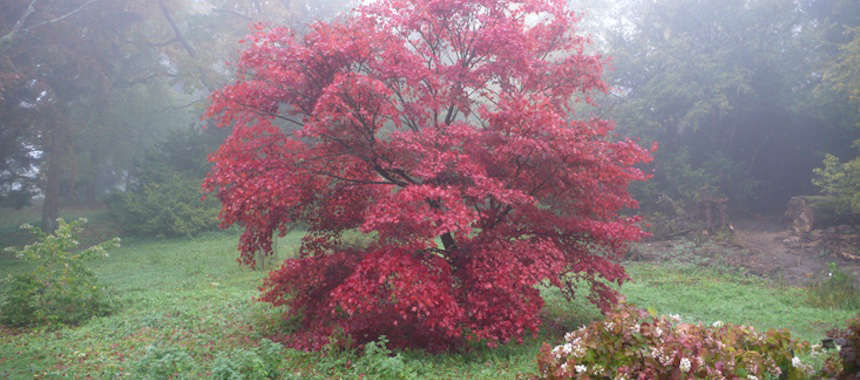

Photography by Britt Willoughby Dyer, except where noted.
Photography by Britt Willoughby Dyer, except where noted.
In a family this diverse, there are lots of characters, from the refined and desirable Japanese maple, via textural snake-bark maple, to sugar maple with its irresistible sap.
In a family this diverse, there are lots of characters, from the refined and desirable Japanese maple, via textural snake-bark maple, to sugar maple with its irresistible sap.
Maple, Acer: “Don’t Call Me Common”
Maple, Acer: “Don’t Call Me Common”
Photograph by Kendra Wilson.
Photograph by Kendra Wilson.
Yellow leaves of a maple, landing in the red canopy of a Japanese Acer, at Batsford Arboretum.
Yellow leaves of a maple, landing in the red canopy of a Japanese Acer, at Batsford Arboretum.
Regular maple may spread with ease, adapting to different soils and light levels, but it is still a showy tree. Palmate leaves can turn a fiery color with no warning in September, indicating that autumn is on its way.
Regular maple may spread with ease, adapting to different soils and light levels, but it is still a showy tree. Palmate leaves can turn a fiery color with no warning in September, indicating that autumn is on its way.
Vine-leafed maple, Acer cissifolium, is native to Japan, and grows to about 30 feet, about half the height of a red maple.
Vine-leafed maple, Acer cissifolium, is native to Japan, and grows to about 30 feet, about half the height of a red maple.
Cheat Sheet
Cheat Sheet
Winged seeds of vine-leafed maple are getting ready to launch themselves into the world.
Winged seeds of vine-leafed maple are getting ready to launch themselves into the world.
Keep It Alive
Keep It Alive
Acer griseum, or paperbark maple, is a slow-growing tree that can be multi-stemmed or standard.
Acer griseum, or paperbark maple, is a slow-growing tree that can be multi-stemmed or standard.
Photograph by Kendra Wilson.
Photograph by Kendra Wilson.
Photograph by Kendra Wilson.
Photograph by Kendra Wilson.
The richly toned bark of Acer griseum is an asset in winter.
The richly toned bark of Acer griseum is an asset in winter.
Maple leaves are shown to advantage against evergreens. Their foliage is often the first to turn color, and it can cling on for longer; the tree shown here is sailing through an English December.
Maple leaves are shown to advantage against evergreens. Their foliage is often the first to turn color, and it can cling on for longer; the tree shown here is sailing through an English December.
Photograph by Kendra Wilson.
Photograph by Kendra Wilson.
Photograph by Kendra Wilson.
Photograph by Kendra Wilson.
Acer palmatum, in its October glory, grows in the damp of Gloucestershire.
Acer palmatum, in its October glory, grows in the damp of Gloucestershire.


